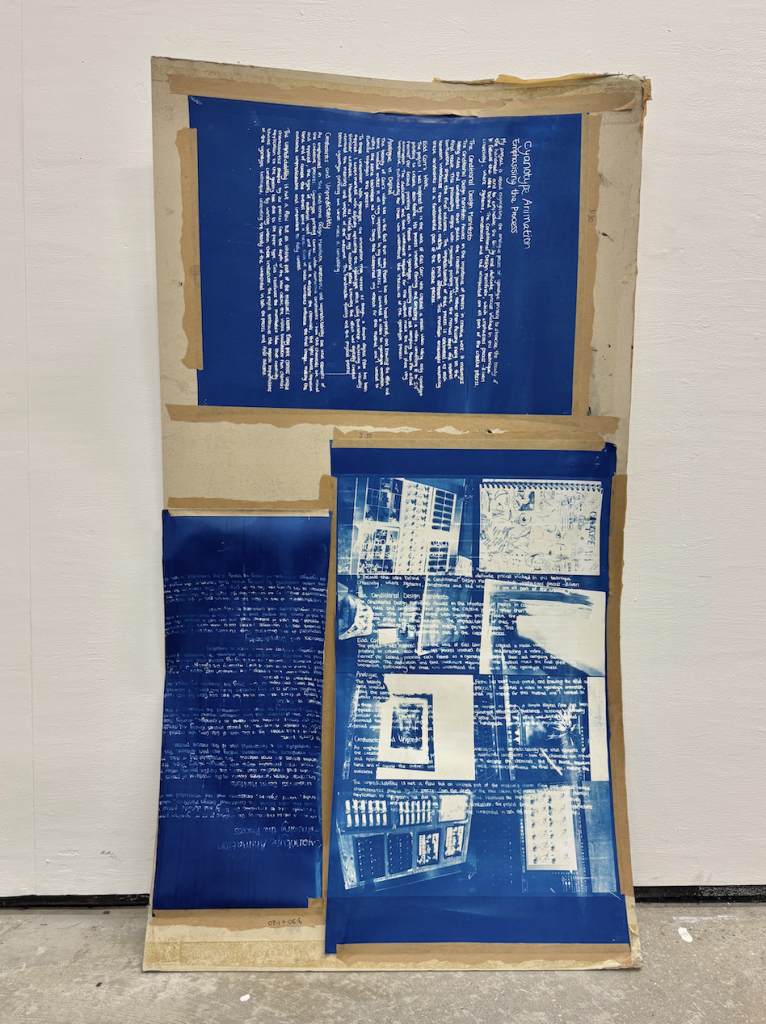methods of iteration
Emphasising the process
edd carr
I looked into Edd Carr’s music video made using cyanotype prints
the process
He shot the video, converted it to 24 frames per second, turned these frames into negatives, printed negatives (9 frames her A4 sheet), and printed about 580 cyanotype sheets in total. He then scanned, cropped and digitally put the frames together as an animation to create a 3:33 long music video.

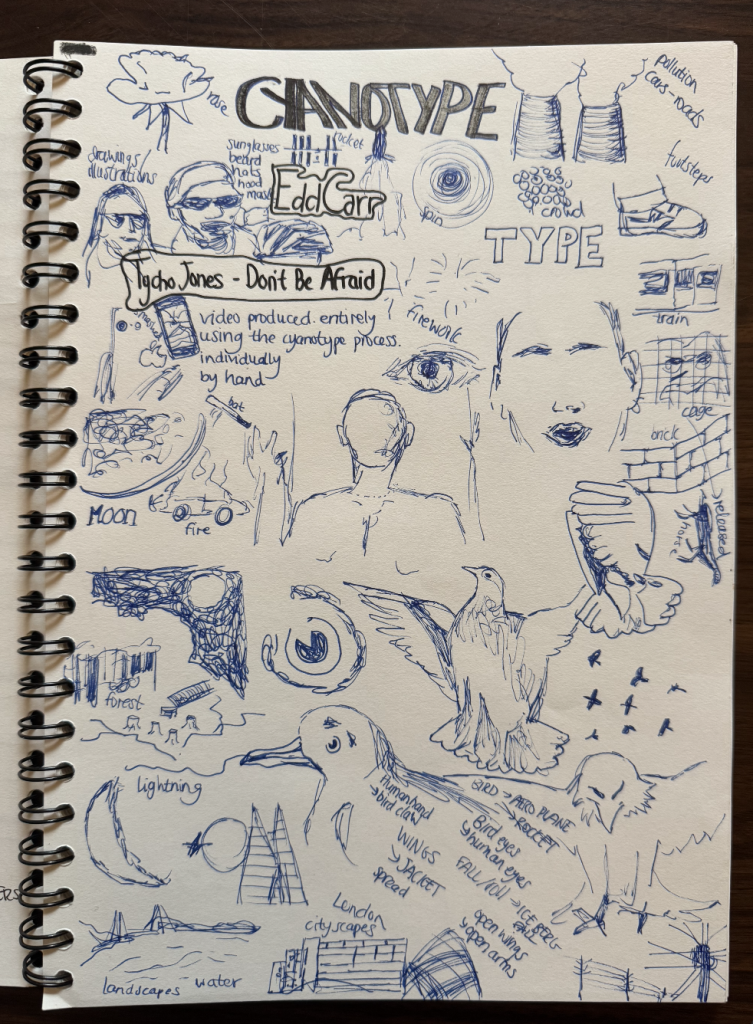
themes
Investigating the themes from Carr’s work and finding some of my own photos and videos based on these themes

replicating edd carr’s process
I converted the videos into 24 frames per second and printed them on negative paper, along with other photos under the same theme. I printed these as cyanotypes and played around with different exposure times under the UV bed. I learnt a lot about the process of cyanotype and experiencing how long it takes to print as well as the attention to detail it requires, it has made me respect Edd Carr’s work so much more.
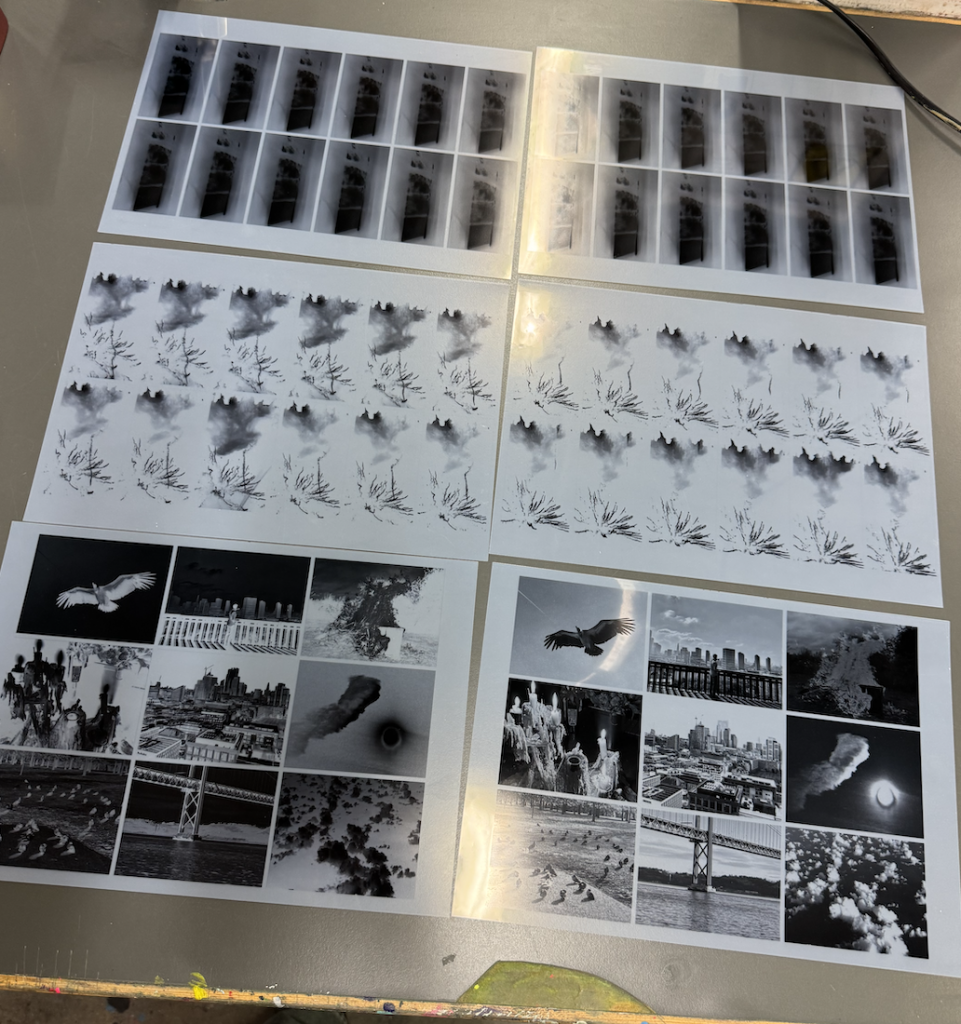
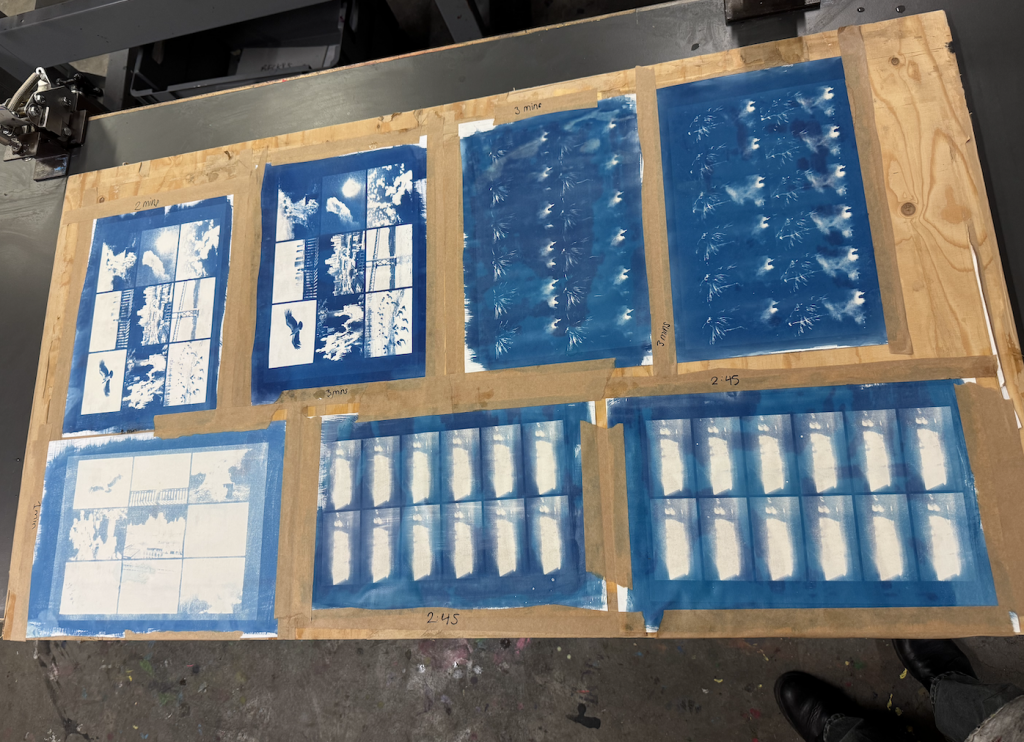
I digitally scanned, cropped and aligned the prints and I put them together frame by frame to create an animation of the video frames and photos.
Analogue vs digital
I replicated my cyanotype animation using only digital tools such as Photoshop and I then compared it to the hand-printed cyanotype animation. This was really interesting to compare and show at the tutorial. It is visible that the digitally edited video doesn’t replicate the same aesthetic as the real cyanotype prints. However, the real comparison is in the value of the work. As also commented on by course mates, knowing that it is replicated digitally makes it loose value compared to being printed by hand.
How can I highlight the analogue and timely process of cyanotype and demonstrate that knowing something is hand-made creates more value?
I created a photographic timeline of the cyanotype printing process and I converted these into negatives

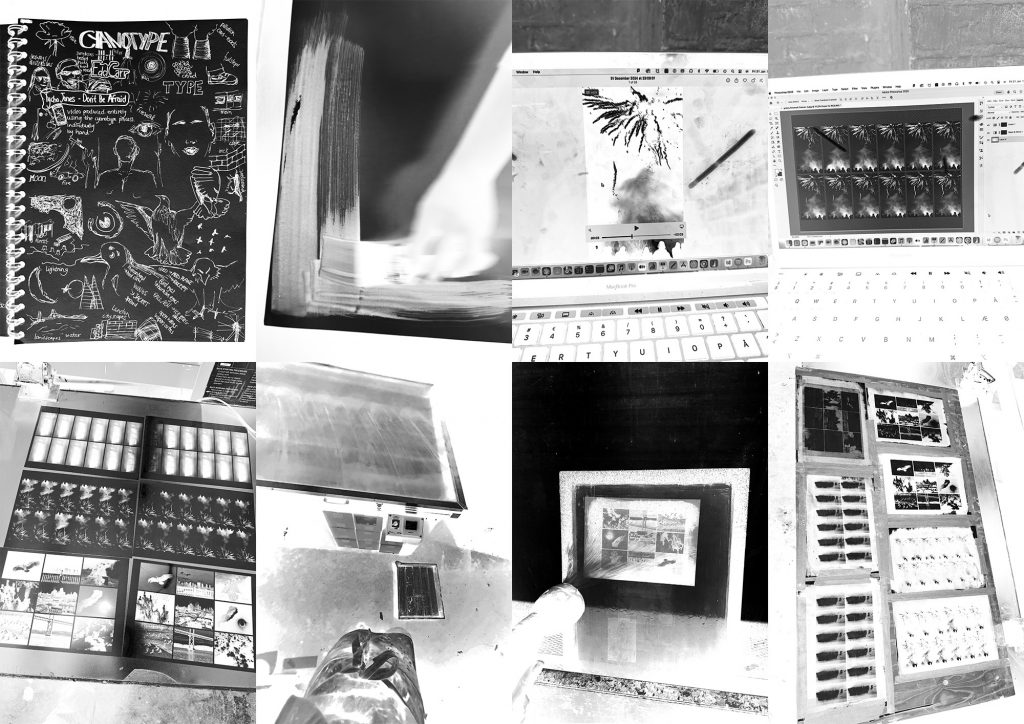
The process is the outcome
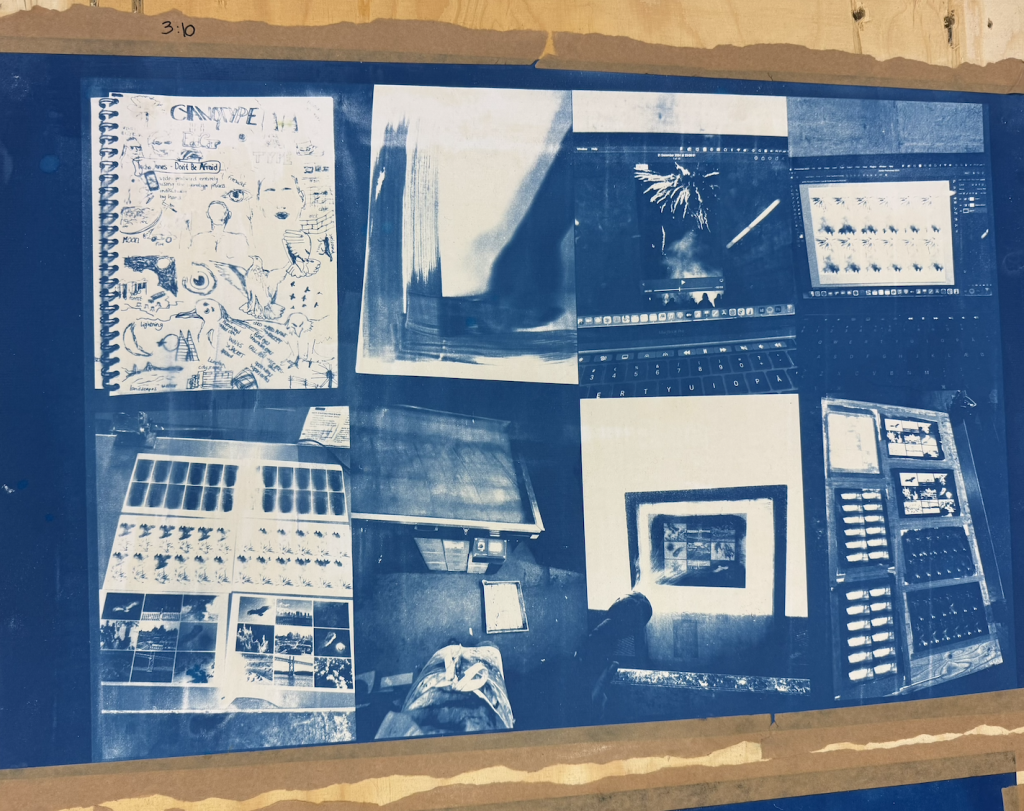

written response
cyanotype animation
What’s unexpected about this thing you just made?
- The length of time it takes and the preparation it requires. Very long process from mixing chemicals, applying chemicals to paper, letting it dry… printing negative prints, exposing prints onto paper, rinsing paper, letting it dry again.
- How successful the outcome of the firework animation turned out. After seeing the negatives and the cyanotype prints on paper, I didn’t think the animation result would be as visually clear as it was.
- It is possible and quite easy to create the sense of motion (using post-production) from photographic video frames or even from a singular still image.
What do you understand better or differently about your tool or medium now?
- Due to the time it takes – especially the drying part – it is more time efficient to coat a lot of paper at once, and do a lot of printing in one go.
- Different materials soak up the chemicals differently. For results with a more even blue colour, it is best to use materials that soak up the chemical when applying. Using a glossy paper type will show more of the chemical application brush strokes and the result of the blue colour will be more patchy.
Did it pose a particular technical challenge? What kind of output or knowledge does this tool or medium favour?
- Because we were the first students using the UV bed for cyanotype printing, we got to experiment with exposure times and learn by ourselves what gives the clearest results.
- Cyanotype favours still images and objects.
What relationship does it have to graphic or communication design?
- In my work as a communication designer, I always find it really interesting to work between analogue and digital media. Using cyanotype, an analogue photo printing technique, where no two prints will be exactly the same and then turning these into a digital moving video, is a fascinating and impressive approach.
The project I am copying is the work of Edd Carr who has produced a music video using only cyanotype prints. He filmed and directed a video and turned it into 24 frames per second and printed these negatives as cyanotypes – and scanned/cropped them to make it into a 3:33 long animation. Visually the video is nice to look at but it is only really impressive to people who know or understand the cyanotype process. To people who have never come across cyanotype, it could look like a digital filter put directly onto the video – which would have saved the artist months of work. But to people who know the process, this video becomes much more fascinating and impressive and these people are the target group. The video has had a lot of press, so this shows that many people do find it impressive.
I want to explore the idea of analogue and digital further. An experiment I would like to try is to use only digitally editing to make a video give the impression it is made using cyanotype. I also want to experiment with the idea of creating motion and movement using only cyanotype, without any digital post-production editing. I want to try this by moving the negative in different ways during exposure – to the side, up/down, zooming in/out, rotating… or through layering the different frames on top of each other.
draft 1
draft 2
Cyanotype Animation through the Lens of the Conditional Design Manifesto
The Conditional Design Manifesto emphasises process-driven creativity, where systems and constraints lead to unexpected outcomes. Applying this perspective to my cyanotype animation project reveals how the structured rules of cyanotype combined with the openness of analogue-digital experimentation shape the outcome and the creative journey and prioritises the process over result.
Embracing Process and Constraints
Cyanotype printing aligns with the manifesto’s emphasis on process over product. Each stage of the cyanotype method: mixing chemicals, applying them to paper, drying, exposing, rinsing, and drying again… introduces constraints that shape the creative process. These constraints, while labor and time intensive, create space for iteration and experimentation.
The materiality of cyanotype reveals the potential of constraints to guide aesthetic decisions. Different paper types absorb chemicals differently, creating unpredictable textures and tones. These “flaws” are not errors but part of the organic and analogue process of cyanotype, highlighting the manifesto’s celebration of unpredictability.
Interaction Between Analogue and Digital
The manifesto’s collaborative view resonates with my project’s interplay between analogue and digital methods. By translating cyanotype prints into an animated video, I explored how analogue imperfections, such as brushstrokes, uneven blues, and paper textures could transform into dynamic visual motion. This process echoes the manifesto’s idea of setting rules and having constraints while allowing open-ended outcomes through the created movement of these handmade details followed by digital post-production editing.
Pushing further, while the current animation relied on digital editing to create motion, I wanted to experiment with analogue-only techniques to generate movement. For example, manipulating negatives during exposure through shifting, rotating, or layering frames which could create motion without digital intervention. This approach aligns with the manifesto’s call to embrace simplicity and the process, reducing reliance on post-production while foregrounding the cyanotype process itself.
Audience Perception
Another key insight from the manifesto is its focus on audience interaction. The cyanotype animation may seem like a digital filter to those unfamiliar with the process, but to those who understand the medium, it becomes an impressive display of craftsmanship. This dual perception reflects the manifesto’s emphasis on the role of human interaction and shared understanding in creative work. To bridge this gap, I could incorporate elements such as behind-the-scenes documentation or process-oriented storytelling.
Advancing the Enquiry
Guided by the Conditional Design Manifesto, I now see my project and cyanotype not merely as an aesthetic method and experimentation but as a structured system of rules and constraints with space for unpredictability that shines light on the process.
Emphasising the Process
My project is about highlighting the analogue process of cyanotype printing to showcase the beauty of the handmade and to emphasise the timely and delicate process involved in this technique. It follows the idea behind The Conditional Design Manifesto, which emphasises process-driven creativity, where systems, constraints and the unexpected are all part of the creative process.
The Conditional Design Manifesto
The Conditional Design Manifesto focuses on the importance of process in creative work. It encourages setting rules and constraints that guide the creative journey, rather than focusing solely on the final result. This philosophy aligns with cyanotype printing, where the manual steps and material limitations shape the final outcome. The unpredictability of this process is celebrated, as each iteration introduces new variations, making each print different. This manifesto encourages embracing these constraints as a fundamental part of the creative process.
Edd Carr’s Work
The project I was inspired by is the work of Edd Carr, who created a music video using only cyanotype printing to create each frame. His process involved filming and directing a video, converting it into 24 frames per second, printing each frame as a cyanotype, scanning them, and compiling them into a final animation. The dedication and time investment required for this method make the final piece very impressive, particularly for those who understand the intricacies of the cyanotype process.
Analogue vs. digital
The beauty of Carr’s video lies in the fact that every frame has been hand-printed, and knowing the effort and time involved. In my own process, I created a cyanotype animation, using the same technique as Carr. Doing this deepened my respect for this method and I wanted to highlight this process.
To those unfamiliar with cyanotype, the animation may appear as though a simple digital filter has been applied. I experimented with digitally replicating the cyanotype effect using Photoshop, achieving a visually similar aesthetic. However, as noted by my tutorial group, knowing the effect was digitally created removed the meaning and impact of the outcome. The handmade quality and the physical process behind cyanotype printing are what make it compelling.
Constraints and unpredictability
As emphasised in The Conditional Design Manifesto, constraints and unpredictability are important elements of the creative process. Cyanotype printing comes with numerous constraints – how the chemicals are mixed and applied, the type of material used and how well it absorbs the chemicals, the light source, and the exposure time and of course the overall time it takes to do this printing technique. Each of these variables influences the final image, making the outcome unpredictable and impossible to fully control.
This unpredictability is not a flaw but an inherent part of the medium’s charm. Every cyanotype print carries unique characteristics shaped by its process, from the depth of the blue colour, the visible brush strokes from chemical application to the grainy look due to the paper type. By working within these limitations, the project embraces the organic imperfections of the cyanotype technique, celebrating the beauty of the unexpected in both the process and the final animation.
final draft
